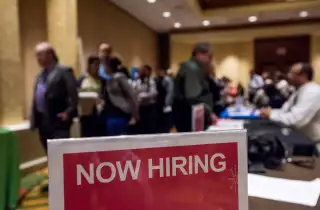What the Surprisingly Awesome Jobs Report Means for Your Money

Investors received what seems like the first bit of good news this year as the Labor Department reported that employers added jobs at a healthy clip in December. The news seems to support the Federal Reserve's decision to raise interest rates last month.
Employment increased by 292,000 jobs, according to the Labor Department, while the unemployment rate remained steady at 5%. Economists had predicted a 200,000 gain. Hourly wages, meanwhile, grew 2.5% over the past year, the 12th consecutive month of greater than 2% growth, although still below pre-recession levels.
"As we move closer to full employment we should see a gradual improvement in wage growth," says Wells Fargo Securities senior economist Sam Bullard.
Today's report comes at a particular volatile moment. Markets have been roiled this week by stock market plunges in China, as regulators halted traded on Monday and Thursday amid two 7% declines. The second suspension of trading occurred a mere half hour into trading on the Shanghai composite index.
China's slowing and transitioning economy has wreaked havoc on commodities as demand for raw materials from the world's second largest economy has declined. Oil prices, for instance, fell yesterday to their lowest point since 2004. The global benchmark Brent crude dropped to $32 a barrel. Meanwhile, North Korea announced that they detonated a hydrogen bomb just as Middle East tensions were growing between Iran and Saudi Arabia.
Read Next: Stocks Plunge Around the World, Renewing Fears of a Bear Market
Even if you haven't been following international news, you probably noticed the fallout in the declining value of your stock holdings. The Dow fell by triple digits again yesterday, dropping 2.3% to 16,514. For the year, the Dow has already sunk nearly 1,000 points.
The sell-off in stocks has proven to be a positive for so-called safe havens. Yields on 10-year Treasury notes, for instance, dropped as much as 0.18 points to 2.12% yesterday (yields decline as prices rise). Meanwhile, the price of gold rose to a two-month high.
"When you have a few geopolitical events happen, investors reawaken and think maybe there is a reason to have diversified insurance for their portfolios," says Dan Denbow, the lead manager of USAA Precious Metals and Minerals Fund.
Low energy prices, weak wage growth, and a strong dollar have led to precious little inflation — a topic the Fed is watching closely.
Members of the Federal Open Market Committee don't expect their preferred gauge of inflation to reach the Fed's 2% target until 2018. Minutes released from the FOMC's December meeting, in which central bankers raised short-term interest rates for the first time in nearly a decade, show Fed officials especially eager to see prices grow at a faster clip.
"The minutes clearly signaled an anxiety about low inflation — so much so that the decision to raise the target rate was a 'close call'," notes IHS Global Insight economists. "Many participants judged that falling energy prices and additional appreciation of the dollar would depress headline inflation longer than previously anticipated."
All of which paints a mixed picture for U.S. economic growth. The World Bank lowered its expectations for global growth, thanks in part to weaker than expected growth in the U.S. A recent disappointing report from a key gauge of use factory activity, the ISM Purchasing Manager's Index, showed that there's reason for concern here at home.
Enter the Fed. Stanley Fischer, the Federal Reserve's vice chairman, said this week on CNBC that officials who projected four interest rate increases this year were "in the ballpark." FOMC members forecast that the Federal funds rate would be at 1.4% at the end of this year.
Market participants are less sure. The futures market puts off the next increase until June, according to the CME FedWatch tool.
The Fed, to its credit, has signaled that it will only increase rates if the economic data supports a move. Just remember last September when the Fed pushed off a widely anticipated hike in part due to trouble in China. So another rate hike, let alone four, are not written on the heart of man by the hand of god.
Whether you see more rate increases or the Fed sits on its hands, expect more volatility in your portfolio as the market wends through the last innings of a mature bull market. Don't sell just because you see scary headlines in the news. After all, China flummoxed investors over the summer only to recover later in the year.
Investors, after all, are rarely rewarded for panicking.